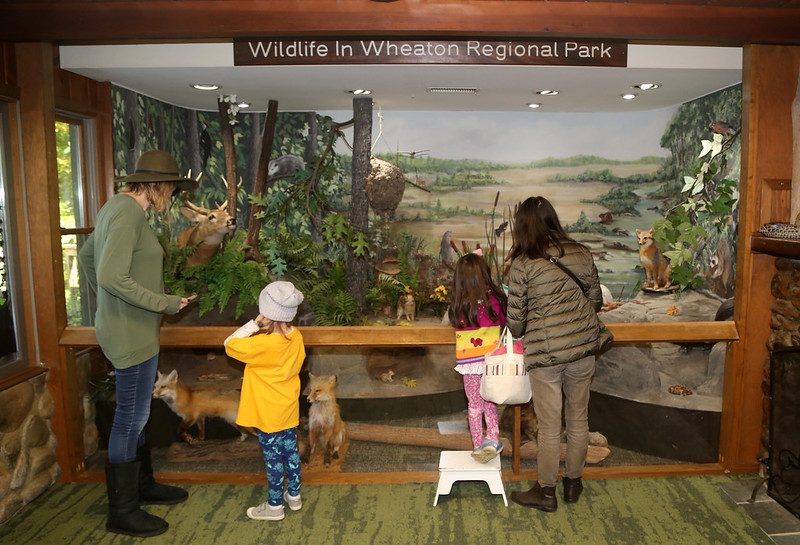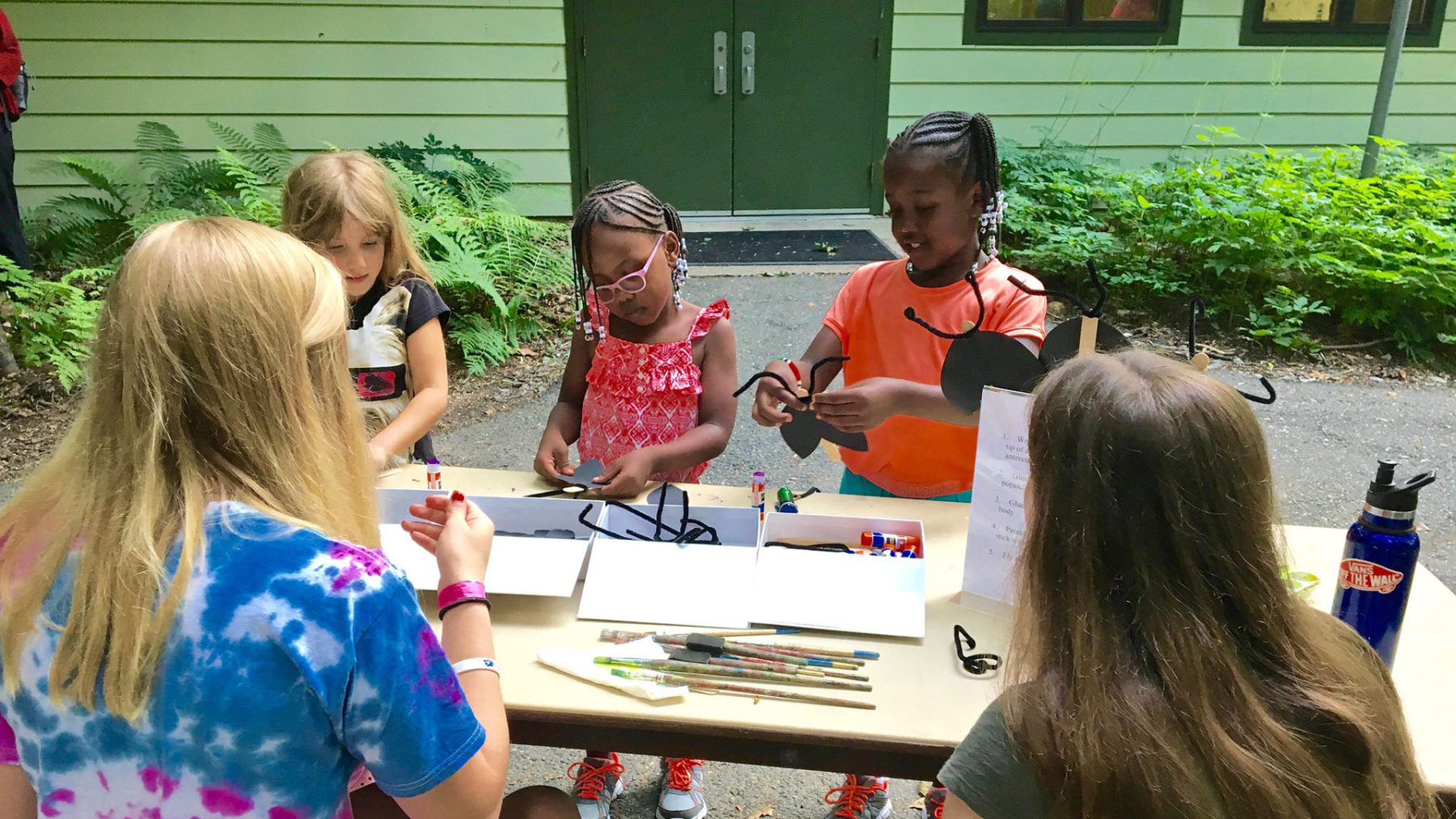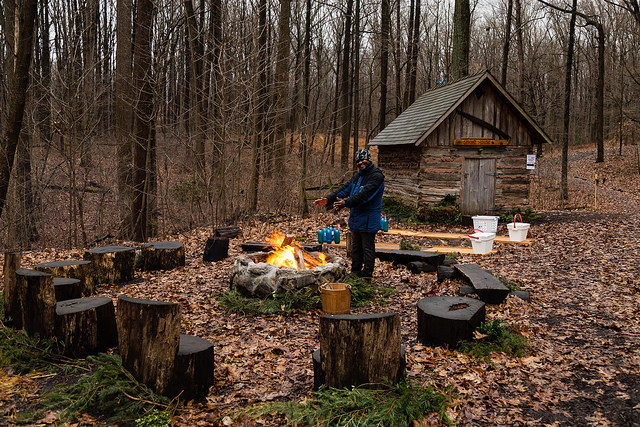
Indoor Exhibits
Wildlife Observation Area
If you want to get up close and personal to a large variety of birds come have a seat in our wildlife Observation Area! Large windows, comfortable rocking chairs and a bentwood bench provide a quiet spot to enjoy watching wildlife in any season. We keep our feeders full to entice our wild neighbors and provide visitors with close up views of our feathery friends.
Children’s Discovery Room

The youngest naturalists will find plenty of ways to sharpen their nature knowledge, and find ways to be engaged with the outdoor world in the Children’s Discovery Room. Our young visitors will use their senses to learn about the outside world, and stretch their imaginations with different nature games and toys. It is a wonderful world – what will you do outdoors with your children before they grow up to help them become stewards of this beautiful planet?
Urban Wildlife
We bring nature indoors with our urban wildlife display showcasing mounts of many bird and animal species that frequent the natural areas around our homes — and often our own backyards.
Live Animals
Our live animals on display include a variety of rescued injured local animals that cannot be released to the wild. You can visit these animals during Nature Center hours and learn about their species. Our Naturalists are always happy to chat!
Outdoor Exhibits
Nature Exploration Area
A play fort, stepping stumps, a giant sand box and more to explore! We hope you will unplug, unwind, and tune in to nature in our Nature Exploration Area.
Ponds and Gardens
The grounds around Brookside Nature Center house water features of various sizes and interest. The largest is adjacent to the parking lot and has an accessible boardwalk with interpretive signage. This is where you’re likely to see a Great Blue Heron or another animal that calls the pond home! Further up the hill, past the Nature Center you’ll find our small wildlife pond. In the spring this is a busy place as frogs and toads congregate and look for mates.
Our many gardens are Bay-friendly, showcasing native plants many of which are host plants for caterpillars and nectar sources for pollinators.
The Thomas Harper Homestead

Step back in time and find out about this cabin, smokehouse, and the family that lived in the cabin.
The log cabin came from a post-Civil War African American community, north of Poolesville, in western Montgomery County. The Harper family built it in 1870 in the community of Jonesville.
The property remained in the Harper family until 1935 when it was sold to Harry L. Willard, who rented it to tenants. His heirs donated the cabin to Montgomery County Department of Parks in 1976. The cabin was dismantled, moved, and reassembled at Brookside Nature Center as part of the US Bicentennial celebration. During reconstruction, the chimney, flooring, windows, and other aging parts of the original house were replaced.
The cabin looked very different when the Harpers lived in it. It had a rear addition, was covered by clapboards which hid the logs, and was white- washed inside and outside. Behind the cabin was a hen house, smokehouse, hog pen, vegetable garden and privy. There was also an orchard with apple, peach, plum, and crabapple trees. The cabin had no electricity or indoor plumbing.
This cabin has one room downstairs and one room upstairs. Access to the upstairs is by an enclosed or “boxed” corner stairway. This is much easier to use than a ladder, and can be closed off to keep heat from escaping to the upper floor. Notice that the chimney is made of sturdy, large creek stones, but in Jonesville it was made of smaller stones and bricks. Originally, it may have been made of mud and sticks. The “V” notching of the logs is the German style, typical in the area. The logs are hand-finished (look for marks left by the adze, a type of ax).
The space between the logs was chinked with stones and mud mixed with hog hair and glue made from boiling down hooves. Though most of the cabin is now chinked with cement for ease of maintenance, a few spots have authentic chinking between the logs. Often, holes were made in the chinking in the summer to allow breezes to blow through, and then refilled in the fall.
The Harper Family
Thomas Harper, his brother John, and their father Alfred are listed in the 1870 census. Thomas (born around 1835) and Elizabeth (1848) Harper raised six children in the cabin: Thomas Jr., Richard, Mary, Ida, Annie, and Julia. Later, their child Richard and spouse Rachel raised fifteen children there, seven of whom are listed in the 1900 census: John, Elizabeth, William, Stanley, Geneva, Ashley, and Arnold.
Jonesville
Jonesville was typical of several dozen family-based communities formed by freed people in Montgomery County after the Civil War. Unlike freed black settlements in other states, Jonesville was on land actually owned by the residents. Slavery was a part of Montgomery County history, peaking at 7572 slaves in the county in 1810. Slavery ended in Maryland on November 1, 1864 with a new state constitution. After the Civil War, Erasmus Jones and his brother Richard purchased 18 acres in Montgomery County. This land formed the core of what would become Jonesville, a community of fifteen families along a road between Jerusalem Road and Cattail Road. The residents of the community were mainly relatives of the Jones brothers.
Everyday Life in a Cabin
Imagine raising ten children in a house this small! It sounds hard, but there are some important things to remember about life in those days. All the children would not have been living in the house at once. By the time the youngest was born, the oldest two or three were out on their own. No children expected to have a room of their own or many toys. They grew up in a close knit family and a community where luxury items were few.
There was no running water in the house. Water needed for drinking, cooking, cleaning and bathing had to be hauled from a spring about 200 feet away. This spring was probably covered by a little stone house, and food that needed to be kept cool was placed in or near the running water. A pit toilet (outhouse) was located on a part of the property furthest away from the spring. Since there was no electricity in the house, light came from kerosene lamps or candles. Cooking was done over a wood or coal stove that also provided heat in the winter.
Furniture consisted of a large table surrounded by chairs and benches, a couple of smaller tables, maybe a rocking chair, and a bed or two. Most of the time the adults slept downstairs and the children upstairs, with curtains separating boys and girls. The beds would have been mats on the floor. In the summer, everyone might have slept downstairs where it was cooler. The outside yard was hard packed clay rather than grass. It was swept with a broom since it was used like another room of the house in warm months.
Everyone helped with chores, which included chopping wood, gardening, feeding the chickens and hogs, collecting eggs, cooking and baking, sweeping the floors, washing, and mending clothes, washing dishes, and hauling water. In springtime, the family needed to till and plant the garden. In the fall, they had to harvest, put up food for the winter, and slaughter the hogs.